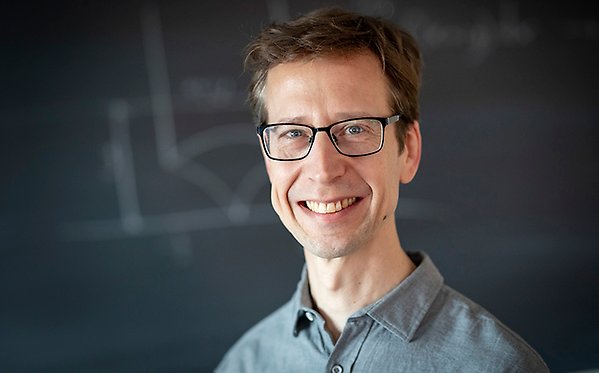Andreas Strömbergsson tells about his research in homogenous dynamics

Andreas Strömbergsson. Photo: Mikael Wallerstedt.
Andreas Strömbergsson was born in 1973 and earned his doctorate in 2001 with the thesis Studies in the analytic and spectral theory of automorphic forms. His dissertation develops several different applications of harmonic analysis on hyperbolic surfaces, i.e., non-Euclidean surfaces with constant negative curvature. Harmonic analysis expresses arbitrary functions as a combination of “intrinsic oscillations,” in this case stemming from the hyperbolic surface.
Harmonic analysis has applications in widely different areas of mathematics. The thesis discusses aspects like a spectral correspondence (Jacquet-Langlands) between completely different types of hyperbolic surfaces and the long-term behaviour of a special type of curves, known as horocycles, on the hyperbolic surfaces.
Andreas conducts research on various applications of dynamical systems in homogeneous spaces. Several of these applications look at collections of a large number of spheres in the space. One question asks what happens if the spheres are allowed to move freely and collide with each other. Another asks how a cloud of moving point particles behaves in a fixed configuration of motionless spheres. A third asks how the spheres can be packed most efficiently, especially in high-dimensional spaces.
“One goal of my research is to contribute new insights on how the Boltzmann equation, which can describe the statistical behaviour of a gas that is not in equilibrium, can be derived from the simple laws of physics of particle motion at the microscopic level.”
Andreas has recently been appointed a Wallenberg Scholar.
“Thanks to that, I have a lot of time to focus on my research and can also have a number of postdocs and doctoral students to collaborate on related projects.”
In the past, Andreas was hesitant to supervise doctoral students.
“It is a very big responsibility. Fifteen years ago, I didn’t know whether I could shoulder it. But now, I have worked with very good doctoral students and found that it is not only a rewarding but even a pleasant task.”
If Andreas had not chosen mathematics, he might have opted to play the violin in an orchestra or work with programming. But he is happy with his career choice:
“Uppsala University is a very nice workplace. I enjoy it here, and I am able to focus on my research.”
Homogenous dynamics
Homogeneous dynamics is a field of research where you study a very special type of dynamical system, the definition of which is based on the theory of Lie groups. There have been several major advances in this field of research over the past 30 years. Results from homogeneous dynamics have also been successfully applied and led to solutions to a number of important problems in number theory and mathematical physics.
